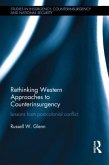Max Schriek
Archaeological Approaches to and Heritage Perspectives on Modern Conflict
Beyond the Battlefields
Max Schriek
Archaeological Approaches to and Heritage Perspectives on Modern Conflict
Beyond the Battlefields
- Gebundenes Buch
- Merkliste
- Auf die Merkliste
- Bewerten Bewerten
- Teilen
- Produkt teilen
- Produkterinnerung
- Produkterinnerung
This study aims to develop a Dutch approach to conflict archaeology, integrating archaeology, heritage research and history at a landscape scale.
Andere Kunden interessierten sich auch für
![Critical Approaches to Heritage for Development Critical Approaches to Heritage for Development]() Critical Approaches to Heritage for Development150,99 €
Critical Approaches to Heritage for Development150,99 €![Personal Perspectives Personal Perspectives]() Personal Perspectives87,99 €
Personal Perspectives87,99 €![Nordic Approaches to Peace Operations Nordic Approaches to Peace Operations]() Peter Viggo JakobsenNordic Approaches to Peace Operations42,99 €
Peter Viggo JakobsenNordic Approaches to Peace Operations42,99 €![The Maritime Archaeology of a Modern Conflict The Maritime Archaeology of a Modern Conflict]() Innes MccartneyThe Maritime Archaeology of a Modern Conflict55,99 €
Innes MccartneyThe Maritime Archaeology of a Modern Conflict55,99 €![Nordic Approaches to Peace Operations Nordic Approaches to Peace Operations]() Peter Viggo JakobsenNordic Approaches to Peace Operations157,99 €
Peter Viggo JakobsenNordic Approaches to Peace Operations157,99 €![European Approaches to United Nations Peacekeeping European Approaches to United Nations Peacekeeping]() European Approaches to United Nations Peacekeeping177,99 €
European Approaches to United Nations Peacekeeping177,99 €![Rethinking Western Approaches to Counterinsurgency Rethinking Western Approaches to Counterinsurgency]() Russell W. GlennRethinking Western Approaches to Counterinsurgency177,99 €
Russell W. GlennRethinking Western Approaches to Counterinsurgency177,99 €-
-
-
This study aims to develop a Dutch approach to conflict archaeology, integrating archaeology, heritage research and history at a landscape scale.
Produktdetails
- Produktdetails
- Verlag: Routledge
- Seitenzahl: 360
- Erscheinungstermin: 27. Januar 2022
- Englisch
- Abmessung: 240mm x 161mm x 24mm
- Gewicht: 705g
- ISBN-13: 9789463729857
- ISBN-10: 9463729852
- Artikelnr.: 62533552
- Herstellerkennzeichnung
- Libri GmbH
- Europaallee 1
- 36244 Bad Hersfeld
- gpsr@libri.de
- Verlag: Routledge
- Seitenzahl: 360
- Erscheinungstermin: 27. Januar 2022
- Englisch
- Abmessung: 240mm x 161mm x 24mm
- Gewicht: 705g
- ISBN-13: 9789463729857
- ISBN-10: 9463729852
- Artikelnr.: 62533552
- Herstellerkennzeichnung
- Libri GmbH
- Europaallee 1
- 36244 Bad Hersfeld
- gpsr@libri.de
Max van der Schriek studied both Heritage Studies (2009) and Archaeology (2010) at the Vrije Universiteit, Amsterdam. Between 2014 and 2019 he conducted his PhD research on modern conflict archaeology in the Netherlands. This was the very first academic study on this topic in the Netherlands.
Acknowledgements
1 Introduction
1.1 The tragedy at Mont Cornillet
1.2 Aims and research perspectives
2 Conflict archaeology
2.1 Historical background
2.2 Roots of war: warlike behaviour in prehistoric times
2.3 Basic principles of total war and modern warfare
2.4 Modern conflict archaeology: methods and techniques
3 Landscape biographies of commemoration
3.1 Landscape biography
3.2 Scope and definition of heritage
3.3 Landscapes of commemoration
3.4 Ypres and the commemoration of WWI
3.5 Potsdamer Platz
Berlin - A multilayered urban landscape of commemoration
4 Status quaestionis of conflict archaeology
4.1 United Kingdom
4.2 Flanders
4.3 France
4.4 Germany
4.5 Poland
4.6 The Netherlands
4.7 Conclusions
5 Scientific and societal importance
5.1 Archaeological heritage management in the Netherlands
5.2 Dutch excavation protocols
5.3 The Buried Past of War project
5.4 Metal detecting in the Netherlands
6 The application of LiDAR-based DEMs
6.1 Light Detecting And Ranging (LiDAR): use and misuse
6.2 Landscapes of conflict - Battlefields and defence works
6.3 Landscapes of conflict - Air power and German logistics
6.4 Landscapes of conflict - Behind the lines
7 Summary and final debate
7.1 Community interest versus scientific interest
7.2 Heritage management versus management of research potential
7.3 Site-oriented approach versus landscape approach
7.4 Research agenda on modern conflict
Synopsis
Appendix: WWII-related archaeological researches in the Netherlands (1984-2017)
Bibliography
Index
1 Introduction
1.1 The tragedy at Mont Cornillet
1.2 Aims and research perspectives
2 Conflict archaeology
2.1 Historical background
2.2 Roots of war: warlike behaviour in prehistoric times
2.3 Basic principles of total war and modern warfare
2.4 Modern conflict archaeology: methods and techniques
3 Landscape biographies of commemoration
3.1 Landscape biography
3.2 Scope and definition of heritage
3.3 Landscapes of commemoration
3.4 Ypres and the commemoration of WWI
3.5 Potsdamer Platz
Berlin - A multilayered urban landscape of commemoration
4 Status quaestionis of conflict archaeology
4.1 United Kingdom
4.2 Flanders
4.3 France
4.4 Germany
4.5 Poland
4.6 The Netherlands
4.7 Conclusions
5 Scientific and societal importance
5.1 Archaeological heritage management in the Netherlands
5.2 Dutch excavation protocols
5.3 The Buried Past of War project
5.4 Metal detecting in the Netherlands
6 The application of LiDAR-based DEMs
6.1 Light Detecting And Ranging (LiDAR): use and misuse
6.2 Landscapes of conflict - Battlefields and defence works
6.3 Landscapes of conflict - Air power and German logistics
6.4 Landscapes of conflict - Behind the lines
7 Summary and final debate
7.1 Community interest versus scientific interest
7.2 Heritage management versus management of research potential
7.3 Site-oriented approach versus landscape approach
7.4 Research agenda on modern conflict
Synopsis
Appendix: WWII-related archaeological researches in the Netherlands (1984-2017)
Bibliography
Index
Acknowledgements
1 Introduction
1.1 The tragedy at Mont Cornillet
1.2 Aims and research perspectives
2 Conflict archaeology
2.1 Historical background
2.2 Roots of war: warlike behaviour in prehistoric times
2.3 Basic principles of total war and modern warfare
2.4 Modern conflict archaeology: methods and techniques
3 Landscape biographies of commemoration
3.1 Landscape biography
3.2 Scope and definition of heritage
3.3 Landscapes of commemoration
3.4 Ypres and the commemoration of WWI
3.5 Potsdamer Platz
Berlin - A multilayered urban landscape of commemoration
4 Status quaestionis of conflict archaeology
4.1 United Kingdom
4.2 Flanders
4.3 France
4.4 Germany
4.5 Poland
4.6 The Netherlands
4.7 Conclusions
5 Scientific and societal importance
5.1 Archaeological heritage management in the Netherlands
5.2 Dutch excavation protocols
5.3 The Buried Past of War project
5.4 Metal detecting in the Netherlands
6 The application of LiDAR-based DEMs
6.1 Light Detecting And Ranging (LiDAR): use and misuse
6.2 Landscapes of conflict - Battlefields and defence works
6.3 Landscapes of conflict - Air power and German logistics
6.4 Landscapes of conflict - Behind the lines
7 Summary and final debate
7.1 Community interest versus scientific interest
7.2 Heritage management versus management of research potential
7.3 Site-oriented approach versus landscape approach
7.4 Research agenda on modern conflict
Synopsis
Appendix: WWII-related archaeological researches in the Netherlands (1984-2017)
Bibliography
Index
1 Introduction
1.1 The tragedy at Mont Cornillet
1.2 Aims and research perspectives
2 Conflict archaeology
2.1 Historical background
2.2 Roots of war: warlike behaviour in prehistoric times
2.3 Basic principles of total war and modern warfare
2.4 Modern conflict archaeology: methods and techniques
3 Landscape biographies of commemoration
3.1 Landscape biography
3.2 Scope and definition of heritage
3.3 Landscapes of commemoration
3.4 Ypres and the commemoration of WWI
3.5 Potsdamer Platz
Berlin - A multilayered urban landscape of commemoration
4 Status quaestionis of conflict archaeology
4.1 United Kingdom
4.2 Flanders
4.3 France
4.4 Germany
4.5 Poland
4.6 The Netherlands
4.7 Conclusions
5 Scientific and societal importance
5.1 Archaeological heritage management in the Netherlands
5.2 Dutch excavation protocols
5.3 The Buried Past of War project
5.4 Metal detecting in the Netherlands
6 The application of LiDAR-based DEMs
6.1 Light Detecting And Ranging (LiDAR): use and misuse
6.2 Landscapes of conflict - Battlefields and defence works
6.3 Landscapes of conflict - Air power and German logistics
6.4 Landscapes of conflict - Behind the lines
7 Summary and final debate
7.1 Community interest versus scientific interest
7.2 Heritage management versus management of research potential
7.3 Site-oriented approach versus landscape approach
7.4 Research agenda on modern conflict
Synopsis
Appendix: WWII-related archaeological researches in the Netherlands (1984-2017)
Bibliography
Index








